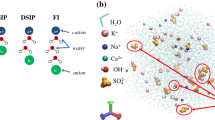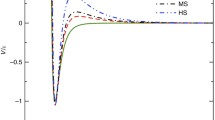Abstract
When trying to reduce the paste content in concrete mixtures for economic reasons, the impact of poor rheology control becomes more prominent. One underlying cause is the incomplete knowledge about force interactions between cement particles originating at the molecular scale. The molecular dynamics simulations presented in this work are conducted with the objective of obtaining a high-resolution picture of the in-plane structure and dynamics of electrolytic solutions confined between two cement clinker surfaces. It was found how the crystalline composition of the solids (i.e., Alite, Belite, Aluminate) impacts the molecular arrangement of the liquid phase and how this in turn affects the magnitude and sign of the forces between the studied surfaces. The differences in peak intensities and locations were explained by the surface-dependent equilibrium between ion correlation, electrostatic repulsive, and at small separations, solvation forces.









Similar content being viewed by others
Notes
Here, cement chemistry industry nomenclature is used: C = CaO, S = SiO2, H = H2O, A = Al2O3.
References
Flatt RJ, Roussel N, Cheeseman CR (2012) Concrete: an eco material that needs to be improved. J Eur Ceram Soc 32(11):2787–2798. https://doi.org/10.1016/j.jeurceramsoc.2011.11.012
Jennings HM, Bullard JW (2011) From electrons to infrastructure: engineering concrete from the bottom up. Cem Concr Res 41(7):727–735. https://doi.org/10.1016/j.cemconres.2011.03.025
Roussel N, Lemaître A, Flatt RJ, Coussot P (2010) Steady state flow of cement suspensions: a micromechanical state of the art. Cem Concr Res 40(1):77–84. https://doi.org/10.1016/j.cemconres.2009.08.026
Vandamme M, Ulm F-J (2009) Nanogranular origin of concrete creep. Proc Natl Acad Sci U S A 106(26):10552–10557. https://doi.org/10.1073/pnas.0901033106
Tavakoli D, Tarighat A (2016) Molecular dynamics study on the mechanical properties of Portland cement clinker phases. Comput Mater Sci 119:65–73. https://doi.org/10.1016/j.commatsci.2016.03.043
Zhou J, Huang J, Jin L (2016) Nano-micro modelling of mechanical properties of cement paste based on molecular dynamics. Adv Cem Res 28(2):73–83. https://doi.org/10.1680/adcr.15.00048
Hou D, Li Z (2015) Large-scale simulation of calcium silicate hydrate by molecular dynamics. Adv Cem Res 27(5):278–288. https://doi.org/10.1680/adcr.13.00096
Bentz DP (2007) Cement hydration: building bridges and dams at the microstructure level. Mater Struct Constr 40(4):397–404. https://doi.org/10.1617/s11527-006-9147-3
Thomas JJ et al (2011) Modeling and simulation of cement hydration kinetics and microstructure development. Cem Concr Res 41(12):1257–1278. https://doi.org/10.1016/j.cemconres.2010.10.004
Flatt RJ (2004) Dispersion forces in cement suspensions. Cem Concr Res 34(3):399–408. https://doi.org/10.1016/j.cemconres.2003.08.019
Nachbaur L, Nkinamubanzi PC, Nonat A, Mutin JC (1998) Electrokinetic properties which control the coagulation of silicate cement suspensions during early age hydration. J Colloid Interface Sci 202(2):261–268. https://doi.org/10.1006/jcis.1998.5445
Lesko S, Lesniewska E, Nonat A, Mutin JC, Goudonnet JP (2001) Investigation by atomic force microscopy of forces at the origin of cement cohesion. Ultramicroscopy 86(1–2):11–21. https://doi.org/10.1016/S0304-3991(00)00091-7
Castillo A, Rozas F, Martínez I, Castellote M (2012) Understanding cementitious materials in fresh state: a nano-scale study on the effect of the mixing time. J Alloys Compd 536(SUPPL. 1):S569–S574. https://doi.org/10.1016/j.jallcom.2011.12.106
Uchikawa H, Hanehara S, Sawaki D (1997) The role of steric repulsive force in the dispersion of cement particles in fresh paste prepared with organic admixture. Cem Concr Res 27(1):37–50. https://doi.org/10.1016/S0008-8846(96)00207-4
Flatt RJ (2004) Towards a prediction of superplasticized concrete rheology. Mater Struct Constr 37(5):289–300. https://doi.org/10.1007/BF02481674
Gallo-Molina JP, Lesage K, Nopens I (2020) Numerical validation of a population balance model describing cement paste rheology. Materials (Basel) 13(5):1249. https://doi.org/10.3390/ma13051249
Flatt RJ, Bowen P (2007) Yield stress of multimodal powder suspensions: an extension of the YODEL (yield stress mODEL). J Am Ceram Soc 90(4):1038–1044. https://doi.org/10.1111/j.1551-2916.2007.01595.x
Roussel N, Geiker MR, Dufour F, Thrane LN, Szabo P (2007) Computational modeling of concrete flow: general overview. Cem Concr Res 37(9):1298–1307. https://doi.org/10.1016/j.cemconres.2007.06.007
Lin TJ, Heinz H (2016) Accurate force field parameters and ph resolved surface models for hydroxyapatite to understand structure, mechanics, hydration, and biological interfaces. J Phys Chem C 120(9):4975–4992. https://doi.org/10.1021/acs.jpcc.5b12504
Derjaguin B, Landau L (1993) Theory of the stability of strongly charged lyophobic soils and of the adhesion of strongly charged particles in solutions of electrolytes. Prog Surf Sci 43(1–4):30–59. https://doi.org/10.1016/0079-6816(93)90013-L
Verwey EJW (1947) Theory of the stability of lyophobic colloids. J Phys Colloid Chem 51(3):631–636. https://doi.org/10.1021/j150453a001
Lomboy G, Sundararajan S, Wang K, Subramaniam S (2011) A test method for determining adhesion forces and Hamaker constants of cementitious materials using atomic force microscopy. Cem Concr Res 41(11):1157–1166. https://doi.org/10.1016/j.cemconres.2011.07.004
Flatt RJ, Bowen P (2003) Electrostatic repulsion between particles in cement suspensions: domain of validity of linearized Poisson-Boltzmann equation for nonideal electrolytes. Cem Concr Res 33(6):781–791. https://doi.org/10.1016/S0008-8846(02)01059-1
Van Damme H (2006) Colloidal chemo-mechanics of cement hydrates and smectite clays: cohesion vs. swelling. Encycl Surf Colloid Sci. https://doi.org/10.1081/E-ESCS-120000583
Plassard C, Lesniewska E, Pochard I, Nonat A (2005) Nanoscale experimental investigation of particle interactions at the origin of the cohesion of cement. Langmuir 21:7263–7270. https://doi.org/10.1021/la050440+
Jönsson B, Wennerström H, Nonat A, Cabane B (2004) Onset of cohesion in cement paste. Langmuir 20(16):6702–6709. https://doi.org/10.1021/la0498760
Taylor HFW (1997) Cement chemistry. Thomas Telford Publishing, London
Kalinichev AG, Wang J, Kirkpatrick RJ (2007) Molecular dynamics modeling of the structure, dynamics and energetics of mineral-water interfaces: application to cement materials. Cem Concr Res 37(3):337–347. https://doi.org/10.1016/j.cemconres.2006.07.004
Wang J, Kalinichev AG, Kirkpatrick RJ (2004) Molecular modeling of water structure in nano-pores between brucite (001) surfaces. Geochim Cosmochim Acta 68(16):3351–3365. https://doi.org/10.1016/j.gca.2004.02.016
Argyris D, Tummala NR, Striolo A, Cole DR (2008) Molecular structure and dynamics in thin water films at the silica and graphite surfaces. J Phys Chem C 112(35):13587–13599. https://doi.org/10.1021/jp803234a
Chougnet A, Audibert A, Moan M (2007) Linear and non-linear rheological behaviour of cement and silica suspensions. Effect of polymer addition. Rheol Acta 46(6):793–802. https://doi.org/10.1007/s00397-006-0126-y
Chougnet A, Palermo T, Audibert A, Moan M (2008) Rheological behaviour of cement and silica suspensions: particle aggregation modelling. Cem Concr Res 38(11):1297–1301. https://doi.org/10.1016/j.cemconres.2008.07.001
Freitas AA, Santos RL, Colaço R, Bayão Horta R, Canongia Lopes JN (2015) From lime to silica and alumina: systematic modeling of cement clinkers using a general force-field. Phys Chem Chem Phys 17(28):18477–18494. https://doi.org/10.1039/c5cp02823j
Todorov IT, Smith W, Trachenko K, Dove MT (2006) DL_POLY_3: new dimensions in molecular dynamics simulations via massive parallelism. J Mater Chem 16(20):1911. https://doi.org/10.1039/b517931a
Downs RT, Hall-Wallace M (2003) The american mineralogist crystal structure database. Am Min 88(1):247–250. https://doi.org/10.5860/choice.43sup-0302
Mishra RK, Flatt RJ, Heinz H (2013) Force field for tricalcium silicate and insight into nanoscale properties: cleavage, initial hydration, and adsorption of organic molecules. J Phys Chem C 117(20):10417–10432. https://doi.org/10.1021/jp312815g
Mishra RK, Fernández-Carrasco L, Flatt RJ, Heinz H (2014) A force field for tricalcium aluminate to characterize surface properties, initial hydration, and organically modified interfaces in atomic resolution. Dalt Trans 43(27):10602–10616. https://doi.org/10.1039/c4dt00438h
Anthony JW, Bideaux RA, Bladh KW, Nichols MC (2017) Handbook of mineralogy. Mineralogical Society of America, Chantilly
Nishi F, Takeuchi Y, Maki I (1985) Tricalcium Silicate Ca3O[SIO4]: The monoclinic superstructure. Zeitschrift für Krist Cryst Mater. https://doi.org/10.1524/zkri.1985.172.14.297
Tsurumi T, Hirano Y, Kato H, Kamiya T, Daimon M (1994) Crystal structure and hydration of belite. Ceram Trans 40:19–25
Mondal P, Jeffery JW (1975) The crystal structure of tricalcium aluminate, Ca 3 Al 2 O 6. Acta Crystallogr Sect B Struct Crystallogr Cryst Chem 31(3):689–697. https://doi.org/10.1107/S0567740875003639
Wu Y, Tepper HL, Voth GA (2006) Flexible simple point-charge water model with improved liquid-state properties. J Chem Phys 124(2):024503. https://doi.org/10.1063/1.2136877
Madura JD, Jorgensen WL (1986) Ab initio and Monte Carlo calculations for a nucleophilic addition reaction in the gas phase and in aqueous solution. J Am Chem Soc 108(10):2517–2527. https://doi.org/10.1021/ja00270a005
De Freitas AA, Shimizu K, Smith AM, Perkin S, CanongiaLopes JN (2018) Structure and dynamics of mica-confined films of [C 10 C 1 Pyrr][NTf 2 ] ionic liquid. J Chem Phys 148(19):1–12. https://doi.org/10.1063/1.5007809
Bartos PJ, Hughes JJ, Trtik P, Zhu W (eds) (2004) Nanotechnology in construction. The Royal Society of Chemistry, Cambridge
Wang Y, Hill K, Harris JG (1993) Thin films of n-octane confined between parallel solid surfaces: structure and adhesive forces vs film thickness from molecular dynamics simulations. J Phys Chem 97(35):9013–9021. https://doi.org/10.1021/j100137a029
Abraham FF (1978) The interfacial density profile of a Lennard-Jones fluid in contact with a (100) Lennard-Jones wall and its relationship to idealized fluid/wall systems: a Monte Carlo simulation. J Chem Phys 68(8):3713–3716. https://doi.org/10.1063/1.436229
Israelachvili J (2011) Intermolecular and surface forces. Third edition. Academic Press
Head-Gordon T, Hura G (2002) Water structure from scattering experiments and simulation. Chem Rev 102(8):2651–2670. https://doi.org/10.1021/cr0006831
Mosaddeghi H, Alavi S, Kowsari MH, Najafi B (2012) Simulations of structural and dynamic anisotropy in nano-confined water between parallel graphite plates. J Chem Phys. https://doi.org/10.1063/1.4763984
Meyer M, Stanley HE (1999) Liquid-liquid phase transition in confined water: a monte carlo study. J Phys Chem B 103(44):9728–9730. https://doi.org/10.1021/jp984142f
Yang Z, Li Q, Chou KC (2009) Structures of water molecules at the interfaces of aqueous salt solutions and silica: cation effects. J Phys Chem C 113(19):8201–8205. https://doi.org/10.1021/jp811517p
Duda Y, Henderson D, Trokhymchuk A, Wasan D (1999) Integral equation study of the solvation force between macroscopic surfaces separated by thin films of diatomic, chain, and network solvents. J Phys Chem B 103(35):7495–7504. https://doi.org/10.1021/jp991193j
Durgun E, Manzano H, Pellenq RJM, Grossman JC (2012) Understanding and controlling the reactivity of the calcium silicate phases from first principles. Chem Mater 24(7):1262–1267. https://doi.org/10.1021/cm203127m
Wang Q, Manzano H, López-Arbeloa I, Shen X (2018) Water adsorption on the β-dicalcium silicate surface from DFT simulations. Minerals 8(9):386. https://doi.org/10.3390/min8090386
Bonnaud PA, Coasne B, Pellenq RJM (2010) Molecular simulation of water confined in nanoporous silica. J Phys Condens Matter. https://doi.org/10.1088/0953-8984/22/28/284110
Manzano H, Pellenq RJM, Ulm F-J, Buehler MJ, van Duin ACT (2012) Hydration of calcium oxide surface predicted by reactive force field molecular dynamics. Langmuir 28(9):4187–4197. https://doi.org/10.1021/la204338m
Flatt RJ (1999) Interparticle forces and superplasticizers in cement suspensions. École Polytechnique Féderale de Lausanne
Finot E, Lesniewska E, Mutin JC, Goudonnet JP (1999) Investigations of surface forces between gypsum crystals in electrolytic solutions using microcantilevers. J Chem Phys 111(14):6590–6598. https://doi.org/10.1063/1.479950
Ferrari L, Kaufmann J, Winnefeld F, Plank J (2010) Interaction of cement model systems with superplasticizers investigated by atomic force microscopy, zeta potential, and adsorption measurements. J Colloid Interface Sci 347(1):15–24. https://doi.org/10.1016/j.jcis.2010.03.005
Israelachvili J (1987) Solvation forces and liquid structure, as probed by direct force measurements. Acc Chem Res 20(11):415–421. https://doi.org/10.1021/ar00143a005
Chapel J-P (1994) Electrolyte species dependent hydration forces between silica surfaces. Langmuir 10(11):4237–4243. https://doi.org/10.1021/la00023a053
Acknowledgements
J.P.G.M., I.N. and K.L. gratefully acknowledge the financial support received from the Research Foundation Flanders through grants G017616N and V431319N. A.A.d.F. and J.N.C.L are grateful for the financial support from Fundação para a Ciência e Tecnologia, FCT/MCTES (Portugal), through CEEC contract IST-ID/93/2018 and projects UIDB/00100/2020, Lisboa/01/0145/FEDER/028367 and PTDC/QUI-QFI/29527/2017.
Author information
Authors and Affiliations
Corresponding author
Ethics declarations
Conflict of interest
The authors declare that they have no conflict of interest.
Additional information
Publisher's Note
Springer Nature remains neutral with regard to jurisdictional claims in published maps and institutional affiliations.
Rights and permissions
About this article
Cite this article
Gallo-Molina, J.P., Alves de Freitas, A., Canongia Lopes, J.N. et al. Molecular dynamics simulations of effective interactions among clinker minerals in aqueous solution and the structure and dynamics of the interstitial water. Mater Struct 54, 133 (2021). https://doi.org/10.1617/s11527-021-01731-9
Received:
Accepted:
Published:
DOI: https://doi.org/10.1617/s11527-021-01731-9




